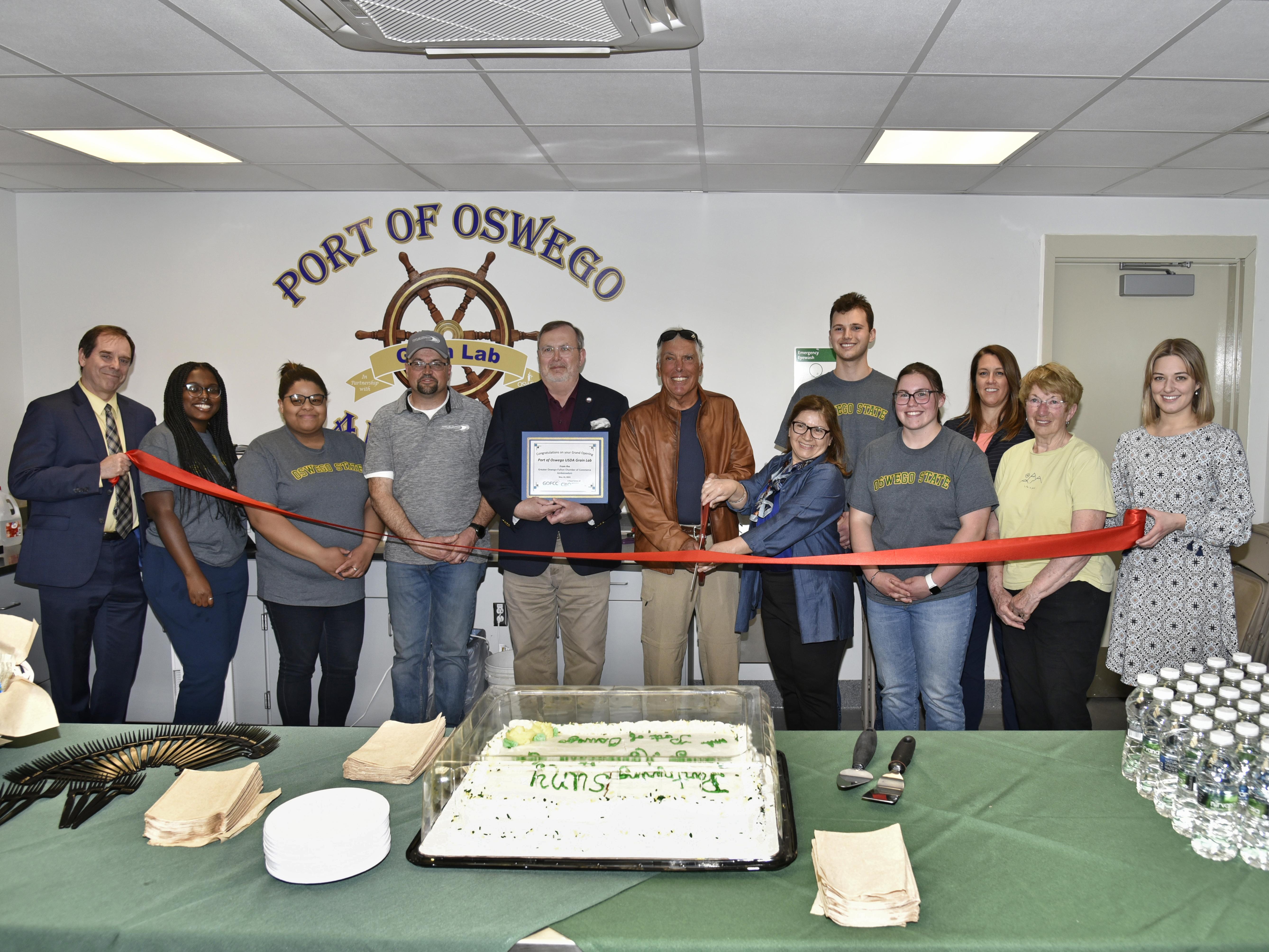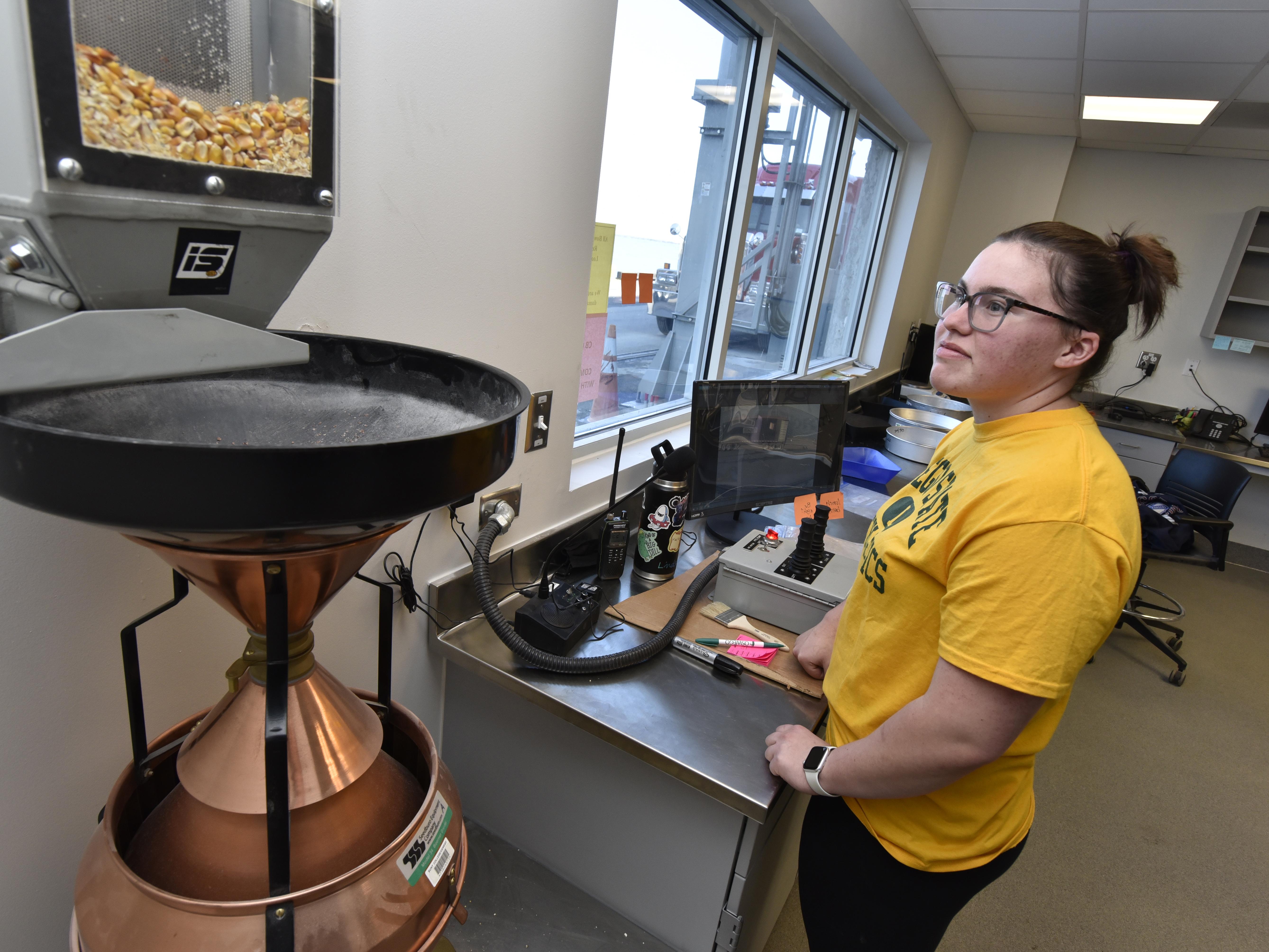SUNY Oswego intern and lab employee Lindsay Fluman checks samples imported into the new grain lab, an ongoing partnership between the Port of Oswego Authority and SUNY Oswego.
A May 10 ribbon cutting ceremony marked the official opening of a new $15 million Grain Export Center, a milestone in a partnership between the Port of Oswego Authority and the SUNY Oswego that preserves the health of consumers and a key supply chain while providing valuable experience to students.
“This lab is the only one of its kind among our sister Great Lakes ports,” said William Scriber, executive director of the Port of Oswego Authority. “There are 15 major international ports and some 50 smaller, regional ports on the Great Lakes-St. Lawrence Seaway system.”
Cleane Medeiros of the college’s biological sciences faculty directs the Agricultural Testing and Analysis Laboratories program that includes paid internships for students with majors that include biochemistry, biology, chemistry and zoology. A $250,000 New York State Department of Agriculture grant purchased equipment for both the lab at the Port and a student training lab on campus.
The lab handles as many as 40 trucks per day, Medeiros said. It generally takes 10 to 15 minutes to check each truck’s load in accordance with United States Department of Agriculture (USDA) standards.
“In that short span of time, we test four major areas,” Medeiros said. “Moisture level in each load is extremely important because too much moisture can lead to the grain overheating in storage or transport. We also test for damaged grain, which could have heat damage or other issues, and for broken corn and toxins such as vomitoxin. Vomitoxin is exactly what it sounds like. If corn with this toxin is used in food products for humans, they can become violently ill.”
Student experience
“We appreciate their assistance and support, while the students gain valuable experience in the field,” Scriber noted.
Students who participate can take part in SUNY Oswego’s new microcredentialing program for grain testing and analysis, which makes students more marketable and competitive when seeking top jobs in their field.
In addition to the hands-on experience that complements their lessons, students also can earn employment opportunities through this arrangement.
“One of our students, for example, interviewed for a position this spring with The Andersons Inc., with whom the Port has a major grain contract,” Medeiros said. Based in Maumee, Ohio, the company leases the Port’s 780,000-bushel grain storage facility and exports the grain on vessels to Europe and Africa.
Comeback story
Oswego, for many years, was a major player both regionally and nationally in grain exports, Scriber said. “This ended in the early 1980s, when the Port’s west pier grain silos were demolished,” he explained. “We aim to bring Oswego back to its prominent position as a major Northeast grain exporter to international markets.”
The Port’s location and partnership with the college make the comeback story viable, Scriber noted.
“Because local farmers can deliver their grain locally — instead of trucking them to Ohio or Baltimore — with a relatively short haul to the Port and water transport, this moves 4,513 truck trips off the road and equates to almost $95,470 in saved road repair costs in the first five years,” Scriber said. “Ships are the most environmentally friendly way to transport goods. For every gallon of fuel per ton of cargo, a ship emits less greenhouse gasses than either truck or rail.”
About 100 farmers from Oswego County and Central New York recently made the first deliveries to the Port export center, which already starts the process of making it a valuable hub. The facility can store up to 22,000 metric tons, or 780,000 bushels, of grain.
“Oswego is home to the largest facility of its kind on Lake Ontario and the most technologically advanced handling system in New York State and on the Great Lakes and has an on-site USDA lab,” Scriber said. “This system can unload a truckload of grain (35,000 lbs.) in less than a minute, and it can load a railcar (100 tons of grain) in just eight minutes. This reduced unloading time allows farmers the ability to flow more grain into the facility.”
The Grain Export Center was funded by the New York State Department of Transportation through a $15 million grant. Construction of the facility has involved scores of local workers and tradespeople, Scriber said.
As one of the most productive ports in North America with nearly 120 vessels and more than one million tons of cargo moving through the port on an annual basis, the Port is a leader not only in domestic shipping, but also international shipping.

The Port of Oswego Authority (POA) recently held a ribbon cutting to officially open its state-of-the-art grain testing lab, a partnership with SUNY Oswego and part of the new $15 million Grain Export Center, said William Scriber, POA executive director. The lab is operated by paid student interns from SUNY Oswego. On-hand for the event were, from left: Scott Furlong, provost and vice president for academic affairs, SUNY Oswego; intern Jon’ Rene Jones; intern Flemmie Tyson Jones; Pat McMahon, POA supervisor, development and maintenance; Scriber; Francis Enwright, chairperson, POA board of directors; SUNY Oswego Professor Cleane Medeiros, director of the Agricultural Testing and Analysis Laboratories; interns Sean Erhardt and Lindsay Fluman; Jill Pippin, dean of the Division of Extended Learning for SUNY Oswego; Connie Cosemento, vice-chairperson, POA board of directors; and Brenna Sherman, Greater Oswego-Fulton Chamber of Commerce.




